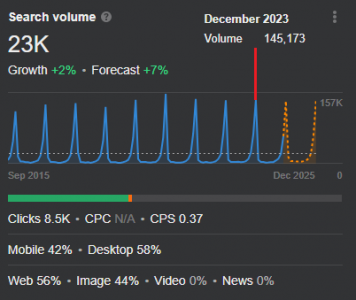
Search volume is a term you’ve probably heard several times in connection with discussions about search engine optimization. Perhaps you’ve heard it as a customer or as someone interested in SEO. In this post, we’ll go through what search volume is, when and how it’s used – and of course, how to find the volumes.
What is search volume?
Search volume refers to the number of searches, on average, for a keyword or phrase within a specific time period. When discussing search volume, the time period is often referred to as a month.
This is something commonly analyzed during keyword research to find terms that can drive as much traffic as possible, provided it is relevant, of course. It can also involve identifying opportunities by finding less competitive keywords, where the competition is often lower.
Examples of search volumes
Below, we can see the search volumes for two different keywords.
Keyword Search volume
| christmas | 23000 |
| new year | 4000 |
(Data sourced from Ahrefs, Sweden)
How to find search volumes?
To see search volumes, you’ll need an SEO tool. There are both free and paid versions available. Here’s a list of some of the most popular tools for finding search volumes:
- Ahrefs
- SEMrush
- Keyword Planner (Free)
- Google Trends (Free, but doesn’t provide exact numbers)
- Keywordtool.io
All of these tools can give you insights into how popular a phrase or keyword is. Some provide more specific numbers, while others give you something more like a measure of popularity, but in any case, they never provide exact figures.
Although some tools, like Ahrefs, source their base data from Google’s Keyword Planner, they often use other data combined with machine learning to make estimates. While realistic estimates can often be made, the numbers should always be taken with a grain of salt.
What is considered high or low search volume?
What qualifies as high or low search volume entirely depends on the type of keyword in question. Several factors come into play, and here are some of the main ones:
- Is it a local search?
- Is it a national or international search?
- Is the search very niche, or does it concern a larger segment?
- Is the search seasonal or cyclical?
All of these factors will, to some extent, influence how many searches are made during different periods.
Seasonal keywords
To show how this works and how some search volumes can be affected by the seasons, let’s look at a few examples.
If we take a closer look at the keywords “Christmas” and “New Year,” we can see clear examples of how search volumes significantly increase as each holiday approaches, only to drop to lower levels once the holiday has passed. Here, we can see how the search volumes have behaved since 2015, along with a forecast for 2025.

(Search volume for “Christmas” in December)

(Search volume for “New Year” in December)
The blue line represents the keyword’s popularity (search volume), and the dashed orange line represents a future forecast.

(Search volume for “Christmas” in June)

(Search volume for “New Year” in June)
Since the full data for December 2024 hasn’t been collected yet, we’ll look at 2023. The graphs clearly show how search volumes increase in December, only to drop once the season has passed.
Keyword Search volume Period
| christmas | 145173 | December 2023 |
| christmas | 3688 | June 2023 |
| new year | 33052 | December 2023 |
| new year | 369 | June 2023 |
This shows how search volume can fluctuate quite drastically, depending on when you check it.
When can this matter?
This can be useful to keep in mind if you run or work with a highly seasonal website.
If your business is based around something that primarily sees demand around, for example, Christmas, it may seem like something has gone wrong with your SEO when the season is over. In reality, you might still hold your top positions, but the demand has temporarily cooled off. Of course, it’s important to verify that this is actually the case, but it’s something to keep in mind when analyzing your organic visibility.
Narrow and broad searches
When talking about “narrow” or “broad” searches, it often refers to how niche or local the keywords are. A few examples of this could be:
- Broad keyword: Camera
- Narrow / niche: Mirrorless camera
- Broad / national: Restaurant
- Local: Restaurant Örnsköldsvik
There is also a type of search phrase known as “long-tail,” which refers to even longer and more specific searches. See our article on long-tail.
How do narrow and broad searches affect search volume?
As we can see from the table below, the search volume generally decreases the more specific the search is.
| Camera (broad) | 12000 |
| Mirrorless camera (narrow) | 90 |
| Restaurant (broad) | 42000 |
| Restaurant Örnsköldsvik (narrow / local) | 1400 |
Search volume and search intent
Although it may be tempting for a niche camera store to optimize a category for “camera” due to the high search volume, this isn’t always the right approach.
If the store primarily focuses on mirrorless cameras, it may be much more relevant to optimize for that keyword, rather than the broader keyword “camera.”
The reason is that someone searching for “camera” could theoretically be interested in any type of camera, while a search for “mirrorless cameras” clearly shows interest in that specific type. Since the store specializes in this, the narrower, more specific keyword is also the most relevant.
The same principle applies to local searches, though it comes with its own considerations. For local SEO, it’s important to expect lower search volumes for the local variant of the keyword compared to the broader, national variant.
Remember relevance over search volume
Aside from explaining what search volumes are, our takeaway here is to keep the focus on relevance. While high search volumes can be tempting, it doesn’t mean that it’s the right keyword for you. Always try to optimize for what you actually offer — it will be easier for you, your customers, and not least for Google.
